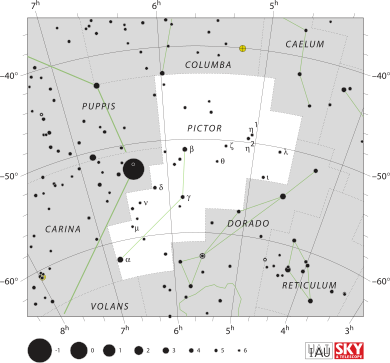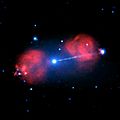Pictor facts for kids
| Constellation | |

List of stars in Pictor
|
|
| Abbreviation | Pic |
|---|---|
| Genitive | Pictoris |
| Pronunciation | genitive |
| Symbolism | Easel |
| Right ascension | 4.53h - 6.85h |
| Declination | −43° - −64° |
| Quadrant | SQ1 |
| Area | 247 sq. deg. (59th) |
| Main stars | 3 |
| Bayer/Flamsteed stars |
15 |
| Stars with planets | 6 |
| Stars brighter than 3.00m | 0 |
| Stars within 10.00 pc (32.62 ly) | 1 |
| Brightest star | α Pic (3.30m) |
| Messier objects | 0 |
| Meteor showers | 0 |
| Bordering constellations |
Caelum Carina Columba Dorado Puppis Volans |
| Visible at latitudes between +26° and −90°. Best visible at 21:00 (9 p.m.) during the month of January. |
|
Pictor is a constellation located in the southern part of the sky. It's found between the bright star Canopus and the Large Magellanic Cloud. The name "Pictor" comes from Latin and means "painter." It's a shorter version of its old name, Equuleus Pictoris, which means "the painter's easel."
This constellation is usually shown as an easel, a stand artists use for painting. It was named by a French astronomer, Abbé Nicolas-Louis de Lacaille, in the 1700s. The brightest star in Pictor is Alpha Pictoris. It's a white star, about 97 light-years away from Earth. Pictor also has a special star system called RR Pictoris. This system suddenly became very bright in 1925, like a nova, before it faded away.
Contents
Exploring Stars and Planets in Pictor
Pictor is home to many interesting stars, some of which have planets orbiting them.
Beta Pictoris: A Star with a Dusty Disk
The second brightest star in Pictor is Beta Pictoris. It's about 63.4 light-years from Earth. This star is famous because it's surrounded by a unique dust disk. This disk has a lot of carbon in it. Scientists have also found an exoplanet (a planet outside our solar system) orbiting Beta Pictoris.
Other Stars with Planets
Besides Beta Pictoris, five other stars in Pictor have planets.
HD 40307: A Star with Six Planets
One of these stars is HD 40307. It's an orange dwarf star, smaller and cooler than our Sun. Six planets orbit this star! One of them, called HD 40307 g, might be a super-Earth. This means it's bigger than Earth but smaller than giant planets like Neptune. It's also in the "habitable zone," which is the right distance from its star for liquid water to exist.
Kapteyn's Star: Our Nearest Neighbor
Kapteyn's Star is the closest star in Pictor to Earth, only 12.76 light-years away. It's a red dwarf star. In 2014, astronomers discovered that Kapteyn's Star also has two super-Earths orbiting it.
Amazing Objects in Deep Space
Pictor isn't just about stars and planets; it also contains incredible objects far out in space.
Pictor A: A Powerful Radio Galaxy
Pictor A is a radio galaxy. This type of galaxy sends out strong radio waves. From its center, a supermassive black hole shoots out a huge jet of plasma. This jet is incredibly long, stretching about 800,000 light-years into space!
GRB 060729: A Long-Lasting Gamma-Ray Burst
In 2006, scientists observed a powerful event in Pictor called GRB 060729. This was a gamma-ray burst, which is a very strong burst of energy. What made this one special was its extremely long X-ray afterglow. The glow could still be seen for almost two years after the initial burst!
Images for kids
-
This image of Pictor A combines X-ray views (blue) from the Chandra X-ray Observatory and radio waves (red) from the Australia Telescope Compact Array. It shows two large lobes and a jet of plasma coming from the galaxy.
See also
 In Spanish: Pictor para niños
In Spanish: Pictor para niños




